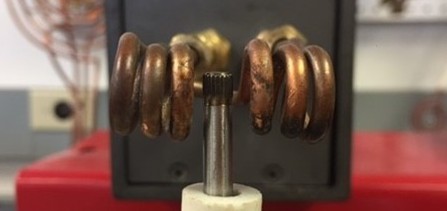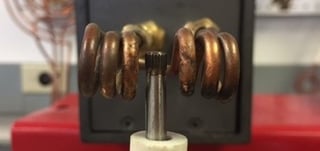Curing Material on an Aluminum Mandrel
Objective Heat a customer supplied aluminum cylinder to 80-120°C for a material curing application. More application notes
Processes
Processes: More
Processes: More

Industries:
Industries: More
Industries: More
Industries: More

Products:
Products: More
Services:
Services: More

Learn:
Learn: More
About:

1 min read
Brett Daly
8/21/17 2:58 PM


A supplier to the automotive industry was looking to heat a cooling fan shaft for a metal-to-plastic insertion (heat staking) application. They needed to heat the end of the shaft to 572 oF (300 oC) within three seconds. They turned to the application engineers at THE LAB at Ambrell to come up with a solution.
An Ambrell EASYHEATTM 2 kW (150-400 kHZ) induction heating solution was determined to be the right system for the application. A custom-designed single position multi-turn split helical coil was built to generate the required heating for this application. Temperature indicating paint was then applied to the part, which dissolves when the part reaches the target temperature. It took just one second to heat the part to temperature, which exceeded the client's heating time goal.
The client turned to induction heating from Ambrell for a number of reasons. First off, THE LAB at Ambrell was able to design a solution that exceeded their requirements. Additionally, the EASYHEAT requires a minimal footprint, heated the part rapidly, and the process is highly repeatable. Finally, induction heating doesn't introduce a flame into the work environment.
Click here to learn about other metal-to-plastic insertion (or heat staking) applications that THE LAB at Ambrell has designed. Interested in getting your application tested by THE LAB? Just fill out this form to get started!


Objective Heat a customer supplied aluminum cylinder to 80-120°C for a material curing application. More application notes

In today’s manufacturing landscape, efficiency, precision, and sustainability are critical. Induction heating—a process that uses electromagnetic...

When it comes to many manufacturing processes, including this forging application, precision and efficiency are critical. Traditional heating methods...